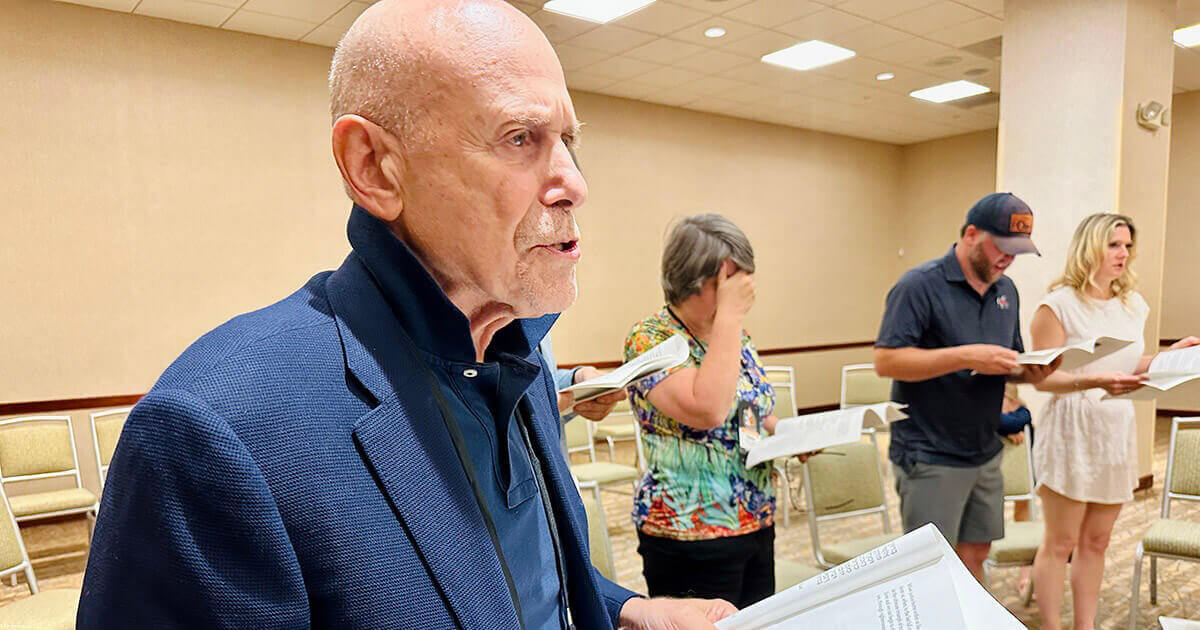Lift Up Your Head, And Be Ye Lifted Up
The protean career of artist Walter Feldman has spanned a variety of disciplines, from traditional oil painting to avant-garde bookmaking. The 78-year-old Lynn, Mass., native, who worked with Willem de Kooning and Josef Albers while studying for his fine arts degree from Yale in 1951, is a printmaker, a painter and a mosaicist. His media — which have garnered such honors as a 1952 Metropolitan Museum of Art Prize and a 1957 Fulbright Fellowship and are included in the collections of the Museum of Modern Art, the Metropolitan Museum of Art and the Victoria and Albert Museum — utilize materials as diverse as 18th-century rag paper and space-age thermoplastic adhesives. After 50 years as a professor of visual arts, he is also the most senior teacher at Brown University. The following has been adapted from remarks to be presented April 11 at the opening of a major retrospective of his work at Brown’s David Winton Bell Gallery.
The first thing that strikes me about Walter Feldman’s works is — for all their lurking violence — their tenderness and delicacy. They maintain grace, as though in defiance of the suffering they sometimes imply. I think this has to do with their pithiness: They distill whatever they depict, with results that are startling, haunting, quietly intense — abstract images that instantly impress themselves on the inner eye. Whatever their medium — paint, print, collage, even sculpture — Feldman’s works have meditative staying power, for they convey archetypal experience. If, as the sociobiologist Edward O. Wilson argues, art exists to express the mythic archetypes of the “human aesthetic,” then Feldman’s art, whether dealing with figure, landscape or language, conveys the quintessentially human in modern aesthetic terms.
An early woodcut print, “The Planter” (1956), seems to me to epitomize much of what follows. “The Planter” is a large black figure set abruptly in the center of a small white space marked by rippling, rough-hewn lines. The strong, solid figure is carved from the flat ground, and seems one with it, even as it stands out from it. Exquisitely shaped with an eccentrically sure line that curves around it with expressionistic force, the anonymous figure bends with great care over a young plant. With bare hands — matching its bare feet — the planter pats down the earth around the plant. We are implicitly in a desert, and the scene is primitive and powerful. The robed figure could be a saint, and the work a sacred icon — as its radical flatness confirms. The point is that a life-affirming and preserving act — symbolized by the ingenious aura the figure’s sheltering arms form around the plant — takes on the quality of a sacrament. With an eloquent economy of means, Feldman conveys hope for the future of life. It is no doubt desperate, but also reassuring.
Feldman has made a number of works that involve Jewish themes, but their artistic transformation implies mastery of the suffering implicit in them, and thus spiritual triumph. “Ezekiel” (1969) is rendered in an abstract image that harks back to “The Planter.” The visionary prophet — he asked God whether bones could live, raising the question of the resurrection — is also a sturdy black shape, but he has been pared to the abstract bone. Perhaps more important emotionally, he stands upright — “The Planter” is bent over, almost horizontal with the ground — in the bleak space. Man survives —if only as a visionary shadow — while the plant may not.
Feldman’s prints and paintings hold their own in the broad modern tradition that extends from early expressionism to late abstraction. But he is also a conceptual artist, as his “Alphabet Series” (1963-65) and “Alphabet House” (1981) suggest. He is involved with letters as images as well as signs, suggesting that his conceptualism has more to do with concrete poetry than with so-called idea art. He is not anti-painting nor, more broadly, an anti-aesthetic artist (what I call a post-artist). For him, language is not the neutral medium some conceptualists have declared it to be. Every letter is subliminally charged with emotional and mystical meaning, an avenue to the sacred human truth. Feldman is a kabbalist, however unacknowledged. He’s a letter mystic, as it were, discovering the mystery in the building blocks of language.
Feldman is the founder of the Ziggurat Press, among the most innovative fine art presses in the country. “The Collage Book” (1990), “Jigsaw Book,” “Perspective,” “Homage to the Great Inventors,” “Song of Songs” and “Ancient Glyphs” (all 1992, clearly a banner year) are unique masterpieces of avant-garde creativity. Each book is pictorial, sculptural and architectural at once — a witty, suggestive unity of the basic mediums. Feldman’s book exists as an object, an idea, a form and a museum of images. It is self-contained and expansive — closed and open-ended, structured and free form. It unfolds in space even as it remains solid and self-same, a kind of three-dimensional, shaped poem. The verbal and visual co-exist and integrate in a consummate visionary object. Images can be read, words can be contemplated — a synergistic reconciliation of irreconcilable modes. Feldman’s model seems to be the ancient Torah, as his “Kaddish Scroll” (1993) suggests. Interestingly, this mournful prayer for the dead is luminous and colorful in Feldman’s abstract rendering, suggesting the joyous resurrection of the dead.
A ziggurat is a primitive temple in the form of a pyramidal tower, planted firmly on the earth and ascending to the sky, step by deliberate step — a three-dimensional sacred space, symbolizing movement from lower to higher consciousness. Each page in Feldman’s book is a step in a ziggurat, building climactically to the liberating sky. Each book is a temple of art as well an homage to the creative human spirit, poetic and exalted with what Theodor Adorno has celebrated as the “auratic-cultic value” of art at its most primordial, that is, art that is aesthetically original because it is attuned to what is original to life. And they bring us back, by reason of their expressionistic urgency, to Feldman’s concern with suffering, especially Jewish suffering, which becomes explicit in “The Final Solution,” part of a series of black-and-white relief prints made in 1996.
“The Final Solution” is horrifically figural. If there is any single image that best conveys the terror of the Holocaust — however
analyzed, it remains emotionally incomprehensible — it is “The Final Solution,” successfully bringing to aesthetic life, which may be the only afterlife, what has come to be fatalistically accepted. The expressionistic animation of the lines; the blankness in the lower space; the Nothingness, an abyss of absence in which all human presence dissolves; the clutter of bones in the upper area, and, above all, the staring skulls, ask once again the question that Ezekiel asked God. Death seems final, and yet the skulls seem to be staring into the infinite distance where God supposedly exists, wondering whether they will be brought to everlasting life. This group of prints is explicitly eschatological and raises the question of the validity of theodicy, which strives to vindicate God for the existence of evil.
After the earthquake that devastated Lisbon, Goethe lost his faith in God. How could God let this happen? Similarly, after the Holocaust, many Jews became atheists (like Feldman’s father). If He existed, they reasoned, He could not have let the Holocaust happen. Feldman has made pieces for a synagogue and a chapel, suggesting that he continues to believe in God. But he also identifies with the victims of the Holocaust: He was badly wounded in the Battle of the Bulge and almost became a skeleton himself. Germany continues to haunt him, as his reminiscences about the event, and the “very Germanic” Josef Albers, suggests. But Feldman’s work escapes the rationalistic rigidity of Albers, turning for inspiration to the irrational, pre-World War I — pre-Albers — Expressionism of the Brücke artists. I am suggesting that at his best Feldman is a Germanic artist. His German artists believed in the spiritual possibilities of suffering, that is, artistic transcendence of history. Thus they believed in God, however subliminally. Feldman struggles with the issue of the Holocaust, which is the end, but he knows that in the beginning was the word — the poetic, creative word of God — and before the word (and perhaps God) the enigmatic letters of the alphabet, signaling that meaning exists in the Nothingness. Indeed, Nothingness has meaning, but it is a meaning on which even the God who exists in the Nothingness depends.
A message from our editor-in-chief Jodi Rudoren

We're building on 127 years of independent journalism to help you develop deeper connections to what it means to be Jewish today.
With so much at stake for the Jewish people right now — war, rising antisemitism, a high-stakes U.S. presidential election — American Jews depend on the Forward's perspective, integrity and courage.
— Jodi Rudoren, Editor-in-Chief






















